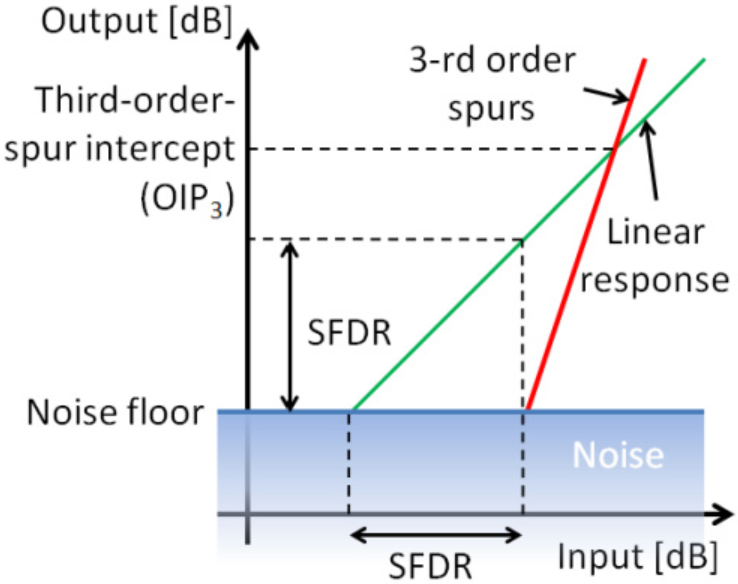Spurious free dynamic range (SFDR) is an important performance measure of a RFOF Link. It is defined as the ratio of the maximum signal without creating detectable distortion to the minimum signal that is just above the system noise floor. Its also defined as the range of the two input signals both are above the noise floor but the third-order products are below the noise floor. The formula to calculate SFDR is below.
SFDR = 2/3 (IIP3dBm – Input Noise Density dBm-Hz)
Where the Input Noise density = KT+NF,
KT = Thermal Nosie and NF is RFoF link Noise figure, it is a measurement of the dynamic range of a RFoF link Typically relative to 1 Hz of bandwidth.
For example, a link with an IIP3 of 33 dBm and an EIN of –133 dBm/Hz would have a SFDR of 110 dB-Hz2/3 over a 1 Hz bandwidth which is typical of OZC RFoF links. The diagram below graphically illustrates the relationship between Input Noise density (noise figure) and Intercept point of the RFoF link

The High SFDR RFoF link is important because it can detect the presence of small signals in the presence of large signals. The way to increase SFDR is either to lower the Optical Transmitter (hence optical Link) Noise Figure by using a lower RIN laser or by operating the link over a narrower frequency band (lower signal modulation Bandwidth) then the SFDR will increase at a 2/3 rate, which is the diff erence between the slope of the output signal and distortion curves, In dB.
The way its measure is when the signal power is increased just up to a point where intermodulation products reach the noise floor for a specific noise bandwidth (channel bandwidth), where Noise and Intermodulation products power are equal.
In general, for stronger signal levels the usable signal range is limited by the Intermodulation products, whereas for weaker signals it is limited by the Noise (Noise Figure or Noise floor) of the link. As general conclusion the higher the Intercept point and the lower Noise figure of the link the higher SFDR will be achieved.
OZC Current RF over Fiber optical transceivers provide dynamic ranges larger than that required of communication equipment in cellular, Satcom and Wi‐Fi systems.
The highest SFDR (115dB-Hz) can be achieved through TEC cooled RFoF links and the SFDR will be stable over wide temperature range. For more information refer the OZ1600 series datasheet, and relative application notes.

